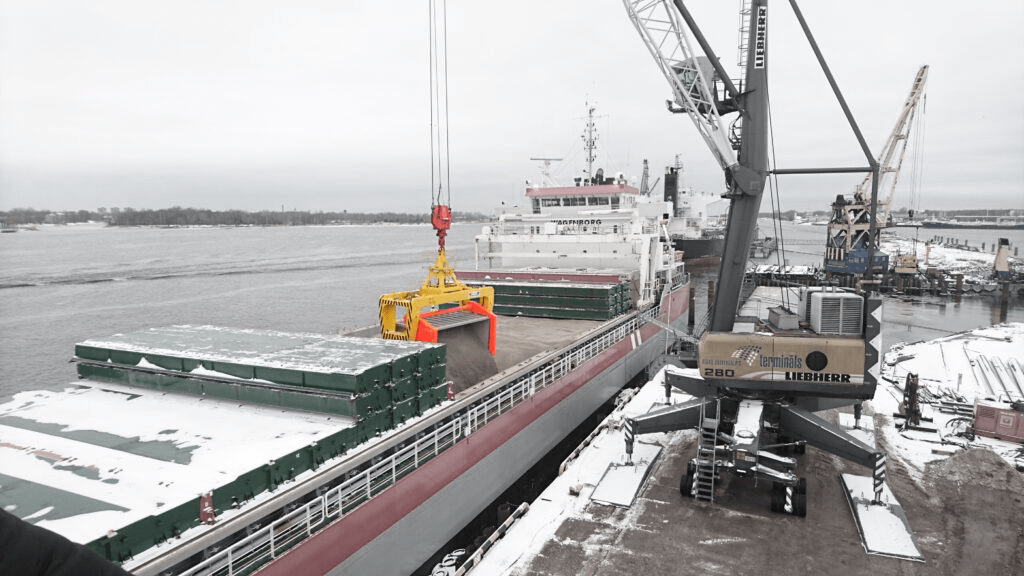What is Containerised Bulk Handling?
Containerised Bulk Handling (CBH) is the popular and fast-growing method of handling bulk commodities cleanly and efficiently. Rather than using traditional open-top wagons or rail cars, CBH uses open-top sealed containers to transport and store bulk, with the final unloading performed by a rotating spreader for use on all types of cranes.
The overall benefit of CBH is that the commodity only sees the light of day immediately before being unloaded at the final destination, which protects the environment and the commodity from contamination or loss.
CBH also allows traditional container terminals to handle bulk, requiring no clean-up after use and no additional stockpile space or bulk sheds needed, as the commodity is stacked in the same manner as standard containers at a port.
Signed, sealed and delivered: The CBH 4-step approach
1. Filling the container at the mine or facility
The first step in containerised bulk handling system is filling the ISO open-top container with bulk at the mine or facility with front-end loaders or conveyors. The containers can generally hold up to 26,580 kg, or 35 cbm of product, depending on the density of the commodity.
2. Sealing container with a lid
An essential part of the process using a forklift truck, the lid is placed on top of the container, where the lid’s auto-latching hooks lock the lid onto the container.
3. Transporting the commodity for import/export
As the containers are of standard ISO design, they can be transported by road and/or by rail without loss of commodity during transportation or transfer.
Using sealed containers to transport bulk is an environmental best practice solution for eliminating commodity loss and contamination during the handling process.
4. Loading at final destination with rotating spreader
At the business end of the CBH operation and the commodities’ final destination is the rotating spreader.
The rotating spreader, available for all types of cranes, picks up the container, locks into the corner castings of the container with twistlocks, and automatically removes the lid from the container before rotating the container through 360 degrees on its horizontal axis. This full rotation ensures that all the commodity is decanted.
Advantages of containerised bulk handling
Preservation
The preservation of the bulk is a significant factor in the success of CBH. Traditional methods of bulk transport, such as open-top rail cars or carriers, expose the material to the elements, resulting in contamination and environmental and financial issues due to loss of commodity during the handling process. CBH protects the commodity and the environment and reduces physical and financial losses by containerising the bulk.
Security
Reducing the risk of theft and tampering with valuable bulk commodities is also how CBH can help. Traditional bulk handling methods, whilst previously seen as a practical solution, can be susceptible to various external temptations, especially with high-value or rare commodities. CBH offers improved security by allowing the sealing commodity to be securely locked, documented, and carefully tracked along its journey.
The speed, cost-effectiveness and flexibility
CBH is a fast-to-market, cost-effective solution that eliminates the need for time-consuming, expensive permanent infrastructures and storage sheds. It allows traditional ports and terminals to export bulk, creating increased revenue and flexibility with no required clean-up.
We are here to help you start the CBH journey
From small to large-scale handling operations, ship-to-shore to reach stacker applications, the RAM CBH system is helping shape the future of bulk handling and can be found in operation on six continents.
Request a callback by clicking the button at the top of the website or find your local sales agent who will help you begin your CBH journey.
Frequently Asked Questions
What is the advantage of CBH over traditional bulk handling methods?
CBH is a more efficient and cost-effective method of transporting bulk materials, as it eliminates commodity loss and contamination, reduces the risk of theft and tampering, and requires no additional infrastructure or clean-up at the port.
How does the rotating spreader work?
The rotating spreader is a device that attaches to the corner castings of the container with twistlocks, and automatically removes the lid from the container before rotating the container through 360 degrees on its horizontal axis. This full rotation ensures that all the commodity is decanted from the container.
Where can I find more information about RAM Spreaders' containerised bulk handling?
You can request a callback by clicking the button at the top of the website or find your local sales agent who will help you begin your CBH journey.
Or, you can head to our containerised bulk handling products to browse.

